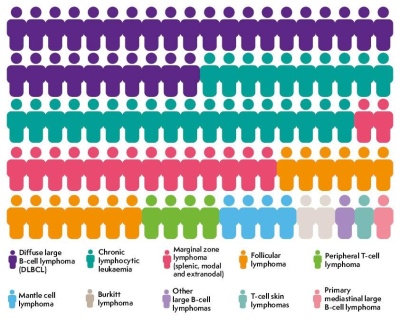Overall, lymphoma is the fifth most common cancer in the UK.
As there are so many types of lymphoma, some types are rare. This graphic from Lymphoma Action shows how common various types of lymphoma are.

About skin (cutaneous) lymphoma
Skin lymphoma – also known as cutaneous lymphoma – is a rare type of non-Hodgkin lymphoma that affects the skin.
There are several different types of high-grade non-Hodgkin lymphoma, and they can develop from B cells or T cells.
B cells and T cells are the two main types of lymphocytes – white blood cells that help us fight infections.
The more common types of skin lymphoma include:
- Mycosis fungoides (MF) – This is the most common type of cutaneous lymphoma. It is usually a very slow-growing type of lymphoma. It often only affects the skin. For most people, mycosis fungoides develops slowly or stays under control for many years. In a small number of people, it may spread to other parts of the body over time.
- Sézary syndrome – In this type of cutaneous T-cell lymphoma, the abnormal T-cells circulate in the blood. They also affect the skin and can be found in other areas of the body, such as lymph nodes. It is usually more rapidly growing than mycosis fungoides.
- Cutaneous B-cell lymphoma – These are very rare. They can either grow slowly (low grade), or they can grow quickly (high-grade).
Treatment depends on a range of factors including the type, size, stage and location of your tumour. It may also depend on your age, general health and genetic factors (linked to the DNA changes in your cells) that tell us how your cancer developed.
When you are diagnosed, your care will be discussed at a multidisciplinary team meeting (MDT) where different specialists will consider the best treatment options for you. Your doctor will discuss this with you so you can decide what is right for you.
We provide a range of specialist treatments for high-grade lymphomas including:
- Chemotherapy
- Radiotherapy
- Targeted treatments and antibody therapy
- Steroids
- Stem cell transplants
- Extracorporeal photopheresis – find out more below
- Clinical trials
- Supportive treatments (such as blood transfusions)
- Treatment to control symptoms (palliative care)
You can find out more about these treatments by clicking the links.
Extracorporeal photopheresis
This is a specialist treatment that uses white blood cells that have been exposed to ultraviolet light to treat skin lymphoma. It is provided in Clatterbridge Cancer Centre – Liverpool by colleagues from NHS Blood and Transplant.
Our Lymphoma and CLL team details are on our general lymphoma page.
Our Cancer Information and Support Centres can provide individualised help and support for patients and families affected by cancer. The team’s main base is in Clatterbridge Cancer Centre – Liverpool but they also work at our Aintree and Wirral hospitals.
There are also local Macmillan services in other hospitals across our region.
External sites that offer extra support and information about different types of skin lymphoma include: